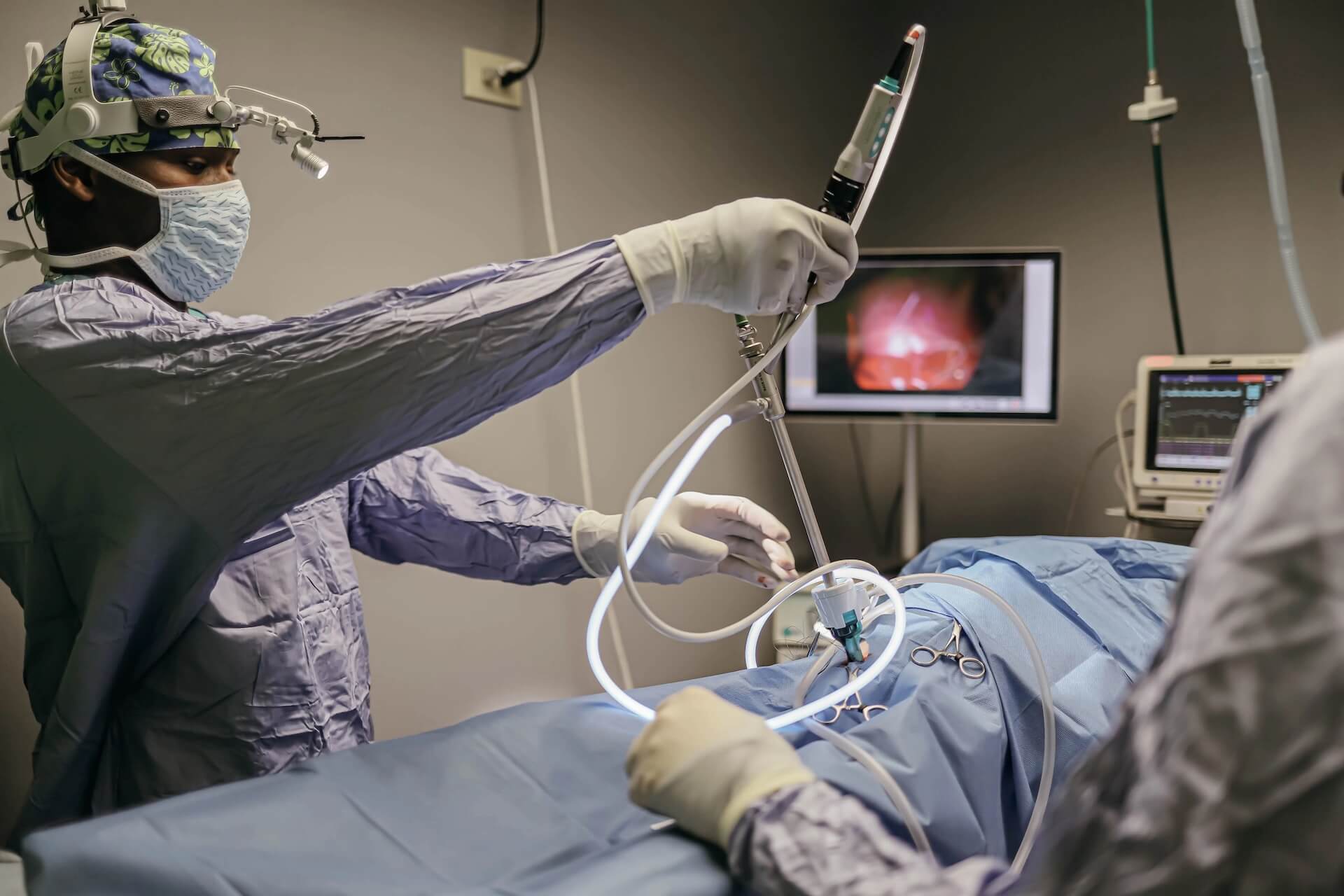 Laparoscopic Surgery is a term used to define a set of procedures in which a small camera is introduced in the belly (abdomen) through a dime-size incision. This allows the veterinarian to see abdominal organs. Some surgical instruments may be introduced through that small opening to perform various surgeries including visual exploration of the organs in the belly, performing a spay, a gastropexy, removing a retained testicle, collecting a biopsy sample, and removing bladder stones.
Laparoscopic Surgery is a term used to define a set of procedures in which a small camera is introduced in the belly (abdomen) through a dime-size incision. This allows the veterinarian to see abdominal organs. Some surgical instruments may be introduced through that small opening to perform various surgeries including visual exploration of the organs in the belly, performing a spay, a gastropexy, removing a retained testicle, collecting a biopsy sample, and removing bladder stones.
Laparoscopy Assisted Exploratory Laparotomy
The camera will allow us to assess the organs in the belly to see how healthy they look. A mass on the spleen or liver can be diagnosed with this procedure and the appropriate biopsy sample may be collected at the same time for accurate diagnosis.
7 Indications for Laparoscopic Assisted Exploratory Laparotomy
- Suspicion of an abdominal mass
- Biopsy of an abdominal mass
- Prophylactic visualization in pets 7 years or older
- Liver biopsy
- Biopsy of the pancreas.
- Diagnosis of ectopic ureters
- Diagnosis confirmation of an intussusception
Laparoscopic Spay
Delicate laparoscopic instruments may be used to remove the ovaries or the ovaries and the uterus when your pet is getting a laparoscopic spay at Liberty Animal Hospital. This technique has the advantage of being less painful than a manual standard spay but also, it allows us to see that there is no bleeding at the end of the procedure. Our patients that have a laparoscopic spay recover faster compared to those that have a manual standard spay.
5 Reasons Why you Should Elect for a Laparoscopic Spay
- 65% less painful than manual, standard spays
- Visual evidence that there is no bleeding at the end of the procedure
- Rapid visualization of the rest of the abdominal organ
- Smaller skin incision
- Faster recovery
Laparoscopic Cryptorchidectomy
Some pets have 1 or both testicles stuck in the belly. Rather than blindly fishing for 1 or both testicles with a standard manual cryptorchid surgery, this laparoscopic surgery method can be used to see the retained testicle(s) and remove them without causing any damage inside the body. The veterinarians at Liberty Animal Hospital have the skillset and the equipment to perform this procedure for your pet.
Checklist for Laparoscopic Cryptorchidectomy
- 1 or both testicles not palpable in the testicular sac after 6 months of age
- 1 or both testicles did not descend in the lineage
- 5 reasons why your pet may have a bladder stone
- Painful belly (abdomen)
- Bloody urine
- Multiple urination in small amounts
- Recurrent urinary tract infections
- Nonspecific signs of illness such as decreased appetite and lethargy
Laparoscopic Gastropexy
When the stomach gets filled with air and the air gets trapped (gastric dilation), this may lead to the stomach flipping (volvulus) and creating a life-threatening condition called gastric dilation and volvulus (GDV). The outer layer of the stomach can be tacked to the body wall to prevent it from flipping. This procedure is called Gastropexy. It can be performed with a scope on a 1-inch skin incision, rather than a 10 inch skin-incision when done manually.
7 Reasons your Dog may be Bloated or have a Twisted Stomach
- Progressively swollen abdomen that sounds like a drum (strike gently with your finger)
- Depressed with a distended abdomen
- Appear to be in pain
- Arched back
- Retching, nothing comes out
- Hypersalivation
- Restless, cannot be comfortable
3 Indications for Laparoscopic Gastropexy/Twisted Stomach (Gastric Dilation and Volvulus)
- Large, deep-chested dog breed (Standard Poodle, Great Dane,
- German Shepherd Dog,
Weimaraner, Irish Setter, Gordon Setter, St Bernard, etc.) - History of twisted stomach in the lineage
Laparoscopy Assisted Cystotomy
Bladder surgery is often indicated when your pet develops a stone in the bladder. Small crystals that are not yet visible to the naked eye may pile up to form small stones. Those stones can become big bladder stones that may cause recurrent urinary tract infections, pain, or keep your pet from peeing (urinary blockage). With this laparoscopic surgery method, the camera that we use is magnified and allows us to see very small stones that we would not see otherwise if the procedure was performed through a standard manual bladder surgery. The level of detail laparoscopy provides prevents missing these small stones, which often leads to a recurrence of the condition and additional expenses.
7 signs your pet might have bladder stones:
- Recurrent urinary tract infections
- Crystals in a routine urine test
- Frequent urination with minimal output
- Dribbling urine
- Bloody urine
- Discomfort during urine voiding
- Painful abdomen
